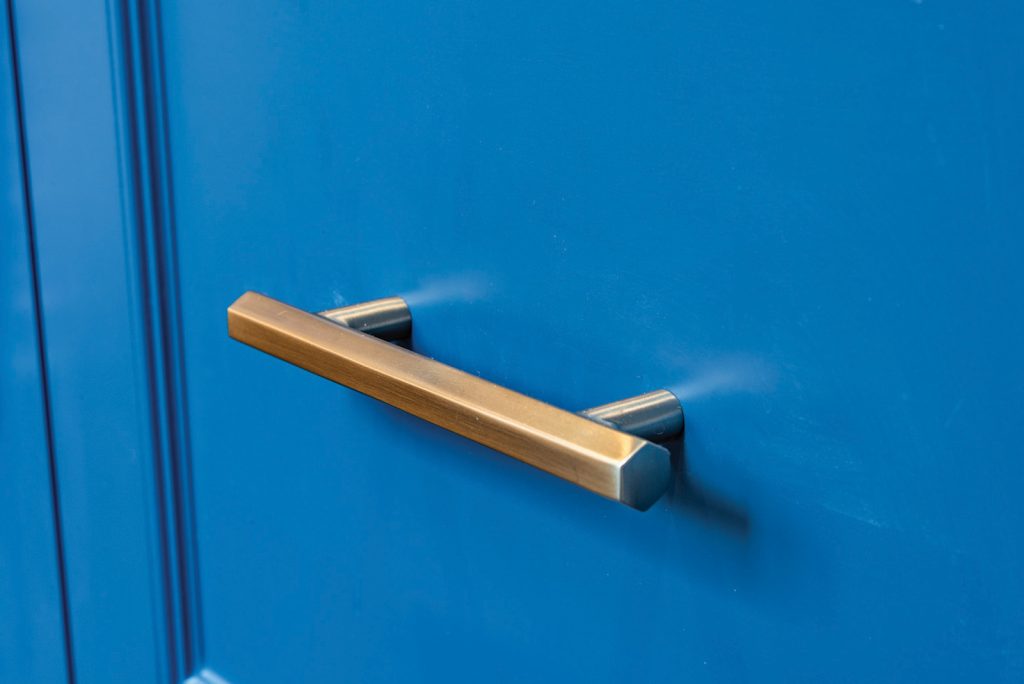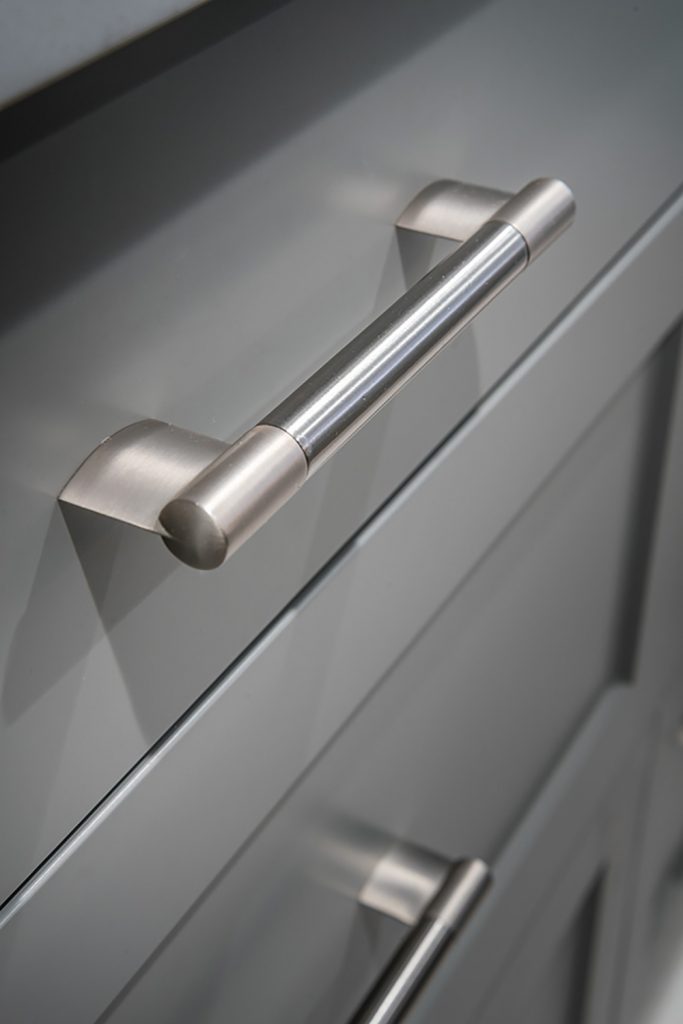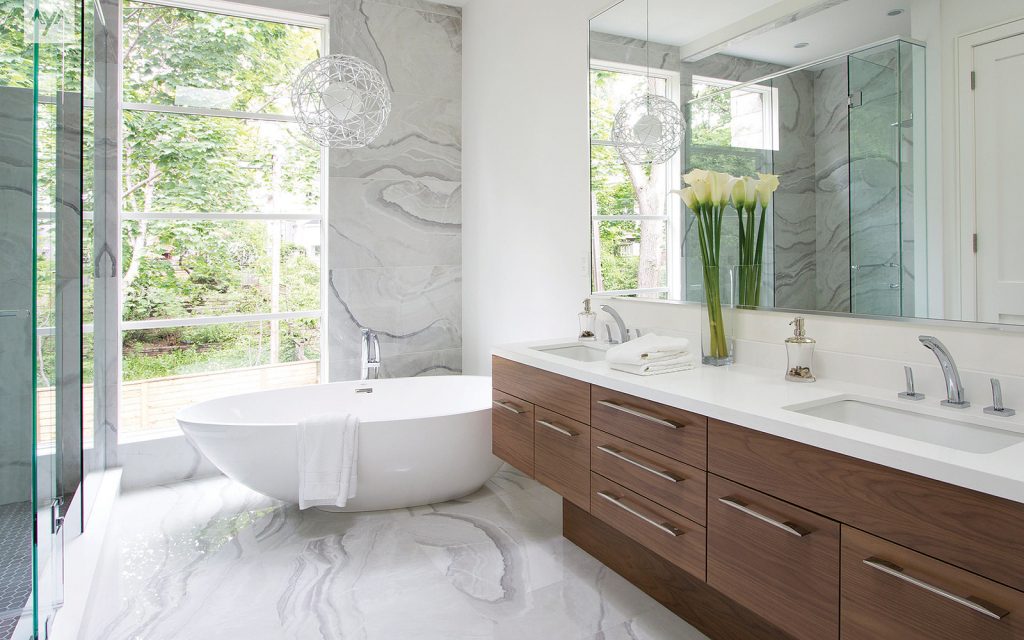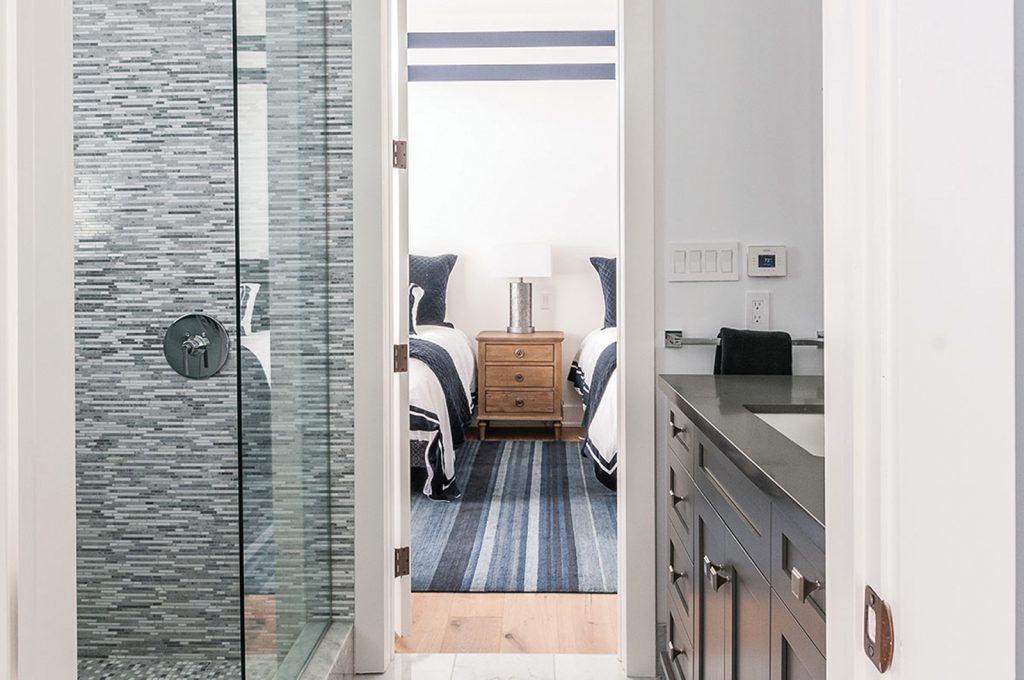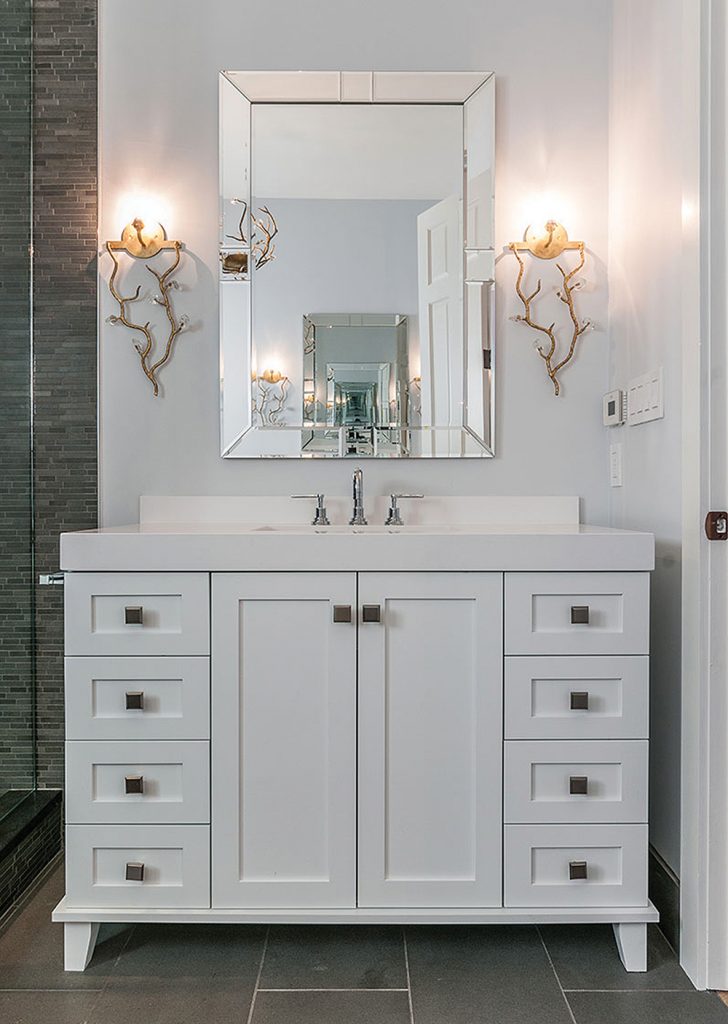Get a handle on the latest trends in kitchen and bath hardware
by Janet Lees
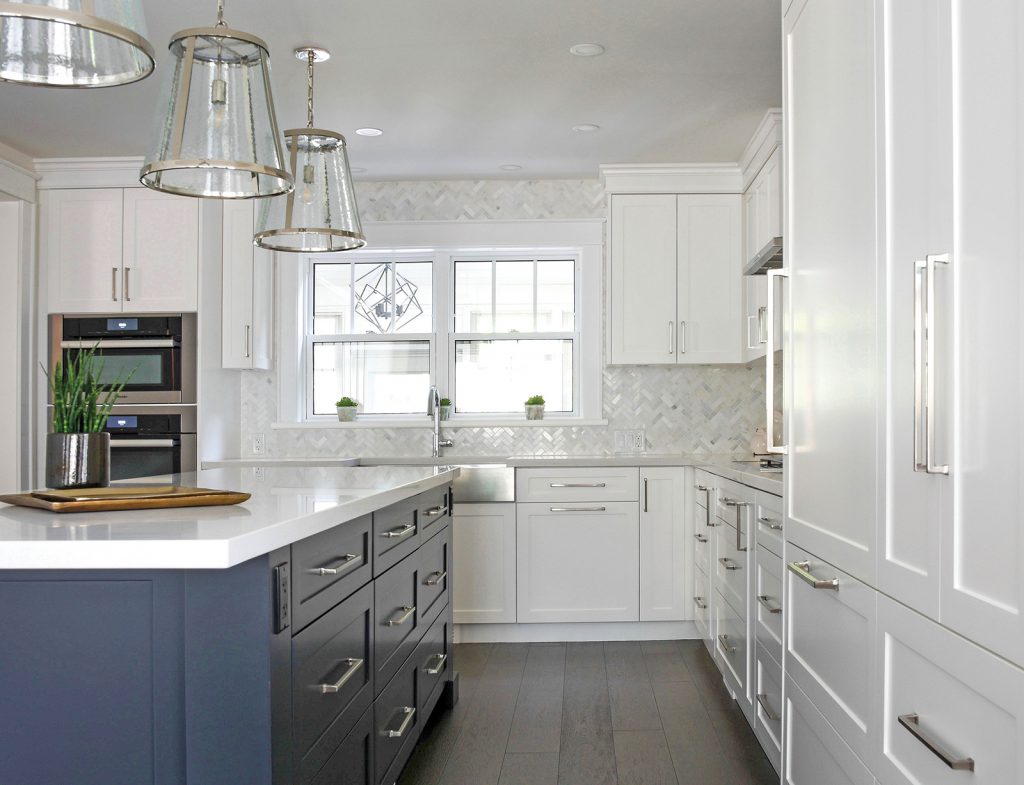
Accessories add the finishing touch to any outfit; a little glitz, a flash of glitter or a hint of glam can go a long way toward turning a ‘ho-hum’ ensemble into a showstopper. Likewise, your kitchen or bathroom can get an instant style makeover by replacing the hardware on your cabinetry. It’s an easy, low-cost and effective way to update your space without having to go to the expense of a complete reno. And if you are remodelling an existing kitchen or bath, or if you’re starting from scratch in a new home, choosing hardware may seem like an afterthought, but it shouldn’t be – your ‘accessories’ can make or break the design and functionality of the two most important rooms in your house.
“Hardware plays a very definitive role in cabinetry, and it should be up there as one of the first things you’re thinking of, not just something that’s thrown on at the end,” says Jillaine Thomson, designer at Cabneato Collingwood. “The wrong hardware is like putting the wrong jewelry on with your black dress.”
These days, the options are practically limitless, so narrowing them down means thinking about the overall ‘look’ you’re going for as well as how functional and durable your hardware needs to be in order to suit your family’s needs. We asked area experts for some insights into current trends along with tips for making the right choice.
“It used to be that people would do stainless appliances and then match all of their hardware to that, but we’re not seeing that as much anymore.”
Sheree Toffan
Tassé Design
Handles
Also called bar pulls, handles are attached to cabinet door fronts with two or more screws. Style can vary greatly, from traditional ‘shaped’ handles to the more industrial look of straight, minimalistic bar pulls. And every style comes in a variety of materials, colours and finishes.
Sleek, contemporary bar pulls are taking the lead as today’s most popular trend, reflecting the move toward the simpler design of flat-panel or Shaker cabinets. Finishes are typically matte, from flat black to brushed nickel, oil-rubbed bronze or even soft gold.
“It used to be that people would do stainless appliances and then match all of their hardware to that, but we’re not seeing that as much anymore,” says Sheree Toffan, senior designer at Tassé Design in Barrie. “They’re doing a matte black hardware, or champagne brass or brushed brass, and we’re seeing a lot plainer cabinet styles, therefore plainer hardware.”
Mixing up the colour palette can also extend to combining two tones of hardware: for example, brushed nickel on the upper cabinets and matte black on the lower, or different hardware on the island (these work particularly well when the cabinets are also different colours). The key is to stay consistent with ‘warm’ or ‘cool’ tones.
“The warm tones are reigning supreme right now: the gold, the brass, the bronze, copper,” notes Thomson. “The warm tones are gorgeous on the darker coloured cabinets. Brass is sort of classic; I don’t think it ever goes out of style. Some people think gold is too much of a trend, but it’s a longer-term trend that will be around for quite a long time.” In cool tones, she says brushed nickel is the most popular. “It’s timeless because it blends with the appliances.”
Bar pulls come in dozens of different lengths and sizes, even within a given style, so you can truly customize your look. However, a word of warning if you’re swapping out old handles for new on existing cabinets: make sure the screws on the new pulls are the same distance apart as the ones you’re replacing. That way you can simply install the new handles using the existing screw holes.
Projection – how far the handle sticks out from the cabinet – is another consideration that’s often overlooked. The handle should be a comfortable fit for all members of the family.
“I always get clients to hold onto the hardware and feel it,” says Katrine Barnstaple, designer at Corinthian Kitchen & Bath Studio in Thornbury. “The wife might have small hands, the husband might have huge hands, so the projection of the pull may not feel right to both of them.”
“I always get clients to hold onto the hardware and feel it. The wife might have small hands, the husband might have huge hands, so the projection of the pull may not feel right to both of them.”
Katrine Barnstaple
Corinthian Kitchen & Bath Studio
Knobs
Knobs are easier to replace than handles because they only have one screw, and therefore one screw hole – no need to worry about lining things up. However, if you’re designing a new kitchen or bath, knobs are best for less-used cupboards and doors.
“If you really want a lasting finish, watch it with knobs,” advises Cabneato’s Thomson. “The finishes tend to wear off around the knob, especially if you’re using it a lot. Because of the way we grab them, nails or rings can scratch, and repeated use can wear away at the finish over time.”
Knobs come in a range of shapes and sizes, and a variety of materials including brass, zinc, stainless steel, bronze, glass, crystal, plastic, wood, and other natural and man-made materials.
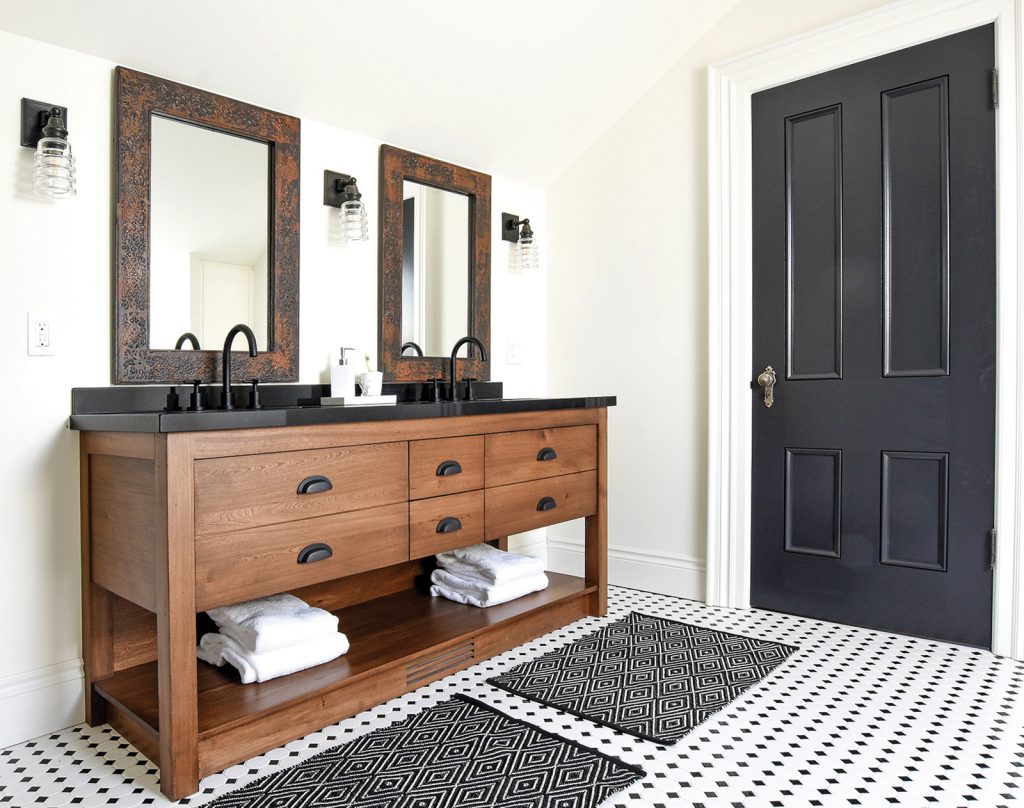
“Hardware plays a very definitive role in cabinetry, and it should be up there as one of the first things you’re thinking of, not just something that’s thrown on at the end.”
Jillaine Thomson
Cabneato Collingwood
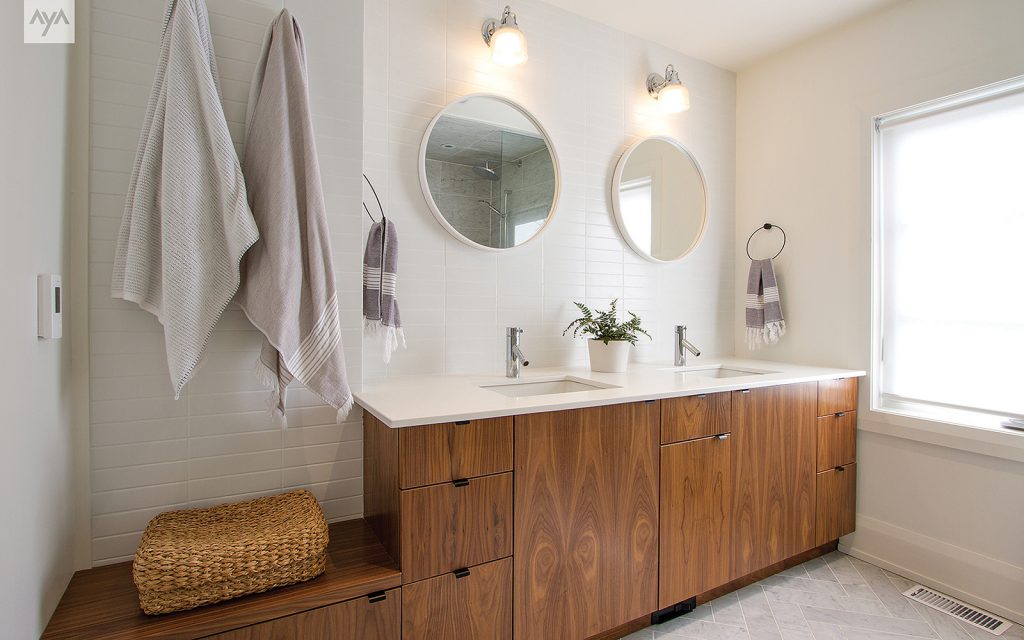
Cup Pulls
These half-moon-shaped pulls were popular in the early 2000s, and they’re still used in traditional kitchens – particularly farmhouse kitchens. Users simply hook their fingers under the cup and pull.
The newer versions have a less rounded, more rectangular shape, so they work equally well with both contemporary and traditional cabinetry. And in addition to antique brass, the latest cup pulls come in pewter, black and even rose gold. “We’re seeing cup pulls and more classic hardware going into the more modern finishes,” says Barnstaple. “It’s a new finish on an old classic.”
Edge Pulls
The latest designer trend, edge pulls (also known as tab pulls or finger pulls) are the most minimalist of the ‘exposed hardware’ options, with only a sliver of metal projecting from the edge of the cabinet for your fingers to slide under. They’re as discreet as they are functional and come in a variety of lengths, from a few inches to the full width of the door or drawer.
“With these sleeker, more modern-looking kitchens, we’re typically using a long, thin handle or these little tab pulls that are kind of hidden underneath the door,” says Dean Mills, owner of Premier Kitchens in Collingwood. “You don’t even see it half the time. It’s very sleek and it’s very hidden.”
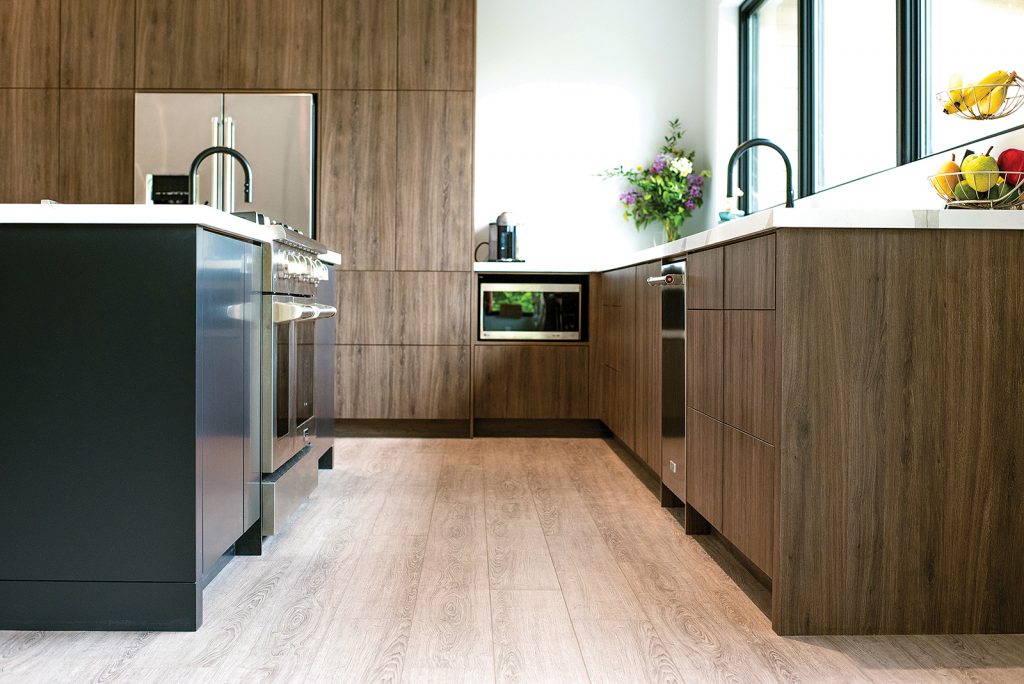
For the ultimate in streamlined sophistication, it’s no longer even necessary to have exposed hardware on your kitchen or bathroom cabinets.
Invisible Hardware
For the ultimate in streamlined sophistication, it’s no longer even necessary to have exposed hardware on your kitchen or bathroom cabinets. With push latches or integrated handles, cabinets can be completely smooth, sleek and unadorned.
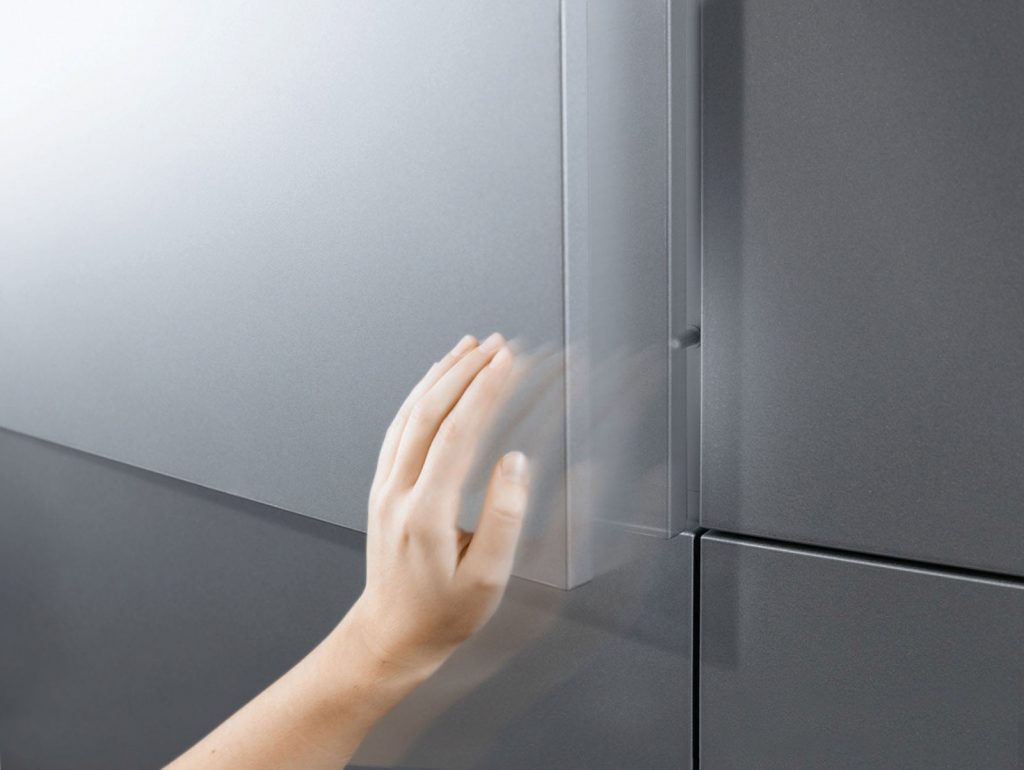
Installed on the inside of your cabinets, a push latch (also known as a touch latch) is a mechanical or magnetic device that allows the doors and drawers to spring open or latch closed with a simple press. No hardware is visible on the outside, and these systems will work with most cabinets.
On the ‘almost invisible’ end of the spectrum, cabinets with integrated handles have an inwardly bevelled edge or channel for your fingers to wrap around, allowing you to pull the door or drawer open. Think of the ‘European-style’ cabinets many builders installed in the ’80s – you know, the white melamine ones with a strip of wood along the bottom – but with a thoroughly modern look. The new designs are seamless in material and colour, and the channel is even more integrated, so the effect is an almost completely invisible means of getting into your cabinets.
Now that hardware has in many ways become superfluous, whether or not you choose to ‘accessorize’ really comes down to personal taste. But there is one caveat to going hardware-less: if you have young children, you may end up spending a lot of time cleaning your cabinets.
“Practicality-wise, people sometimes go for touch hardware, and then decide they want to put handles on afterwards because there are grimy handprints and they’re having to clean their cabinets more than they anticipated,” notes Barnstaple. “Also, with base cabinets, if you lean against the doors, they can pop open, and that can become irritating, too.”
Hinges
You’ll also need to think about how visible your hinges will be – do you want them to be a major design feature, mounted directly to both the outside of the frame and the outside of the cabinet (known as a surface-mounted hinge)? Or would you prefer to take a more minimalistic approach, with the hinges virtually invisible from the outside when the cabinets are closed (known as a concealed hinge)? The current trend is toward hidden hinges, in keeping with the sleeker design sensibility.
There is also a ‘soft close’ hinge option, which has been popular on drawers for several years and is now available for cupboards. “When you go to close the drawer, the mechanism sucks it back in, so you don’t have to worry about pushing all the way in; you get it three-quarters of the way in and the drawer has a spring that draws it in softly,” explains Mills. “Doors can also have a soft-close hinge system now that has a piston inside of it. You get it started and the piston slows it down so that it closes gently. It’s kind of slick.”

“With these sleeker, more modern-looking kitchens, we’re typically using a long, thin handle or these little tab pulls that are kind of hidden underneath the door,”
Dean Mills
Premier Kitchens
The experts agree that the move toward modern design in kitchen and bath hardware has filtered down from Europe to Toronto, and from there to Southern Georgian Bay. “I used to see it in my European magazines 15 years ago, and I’ve been seeing it coming here in a popular way for the last three years,” says Thomson. “It’s a really exciting time.”
Whether you’re looking for a quick makeover or designing your dream kitchen or bath, the right hardware can go a long way to making a ‘wow’ statement. But if, like most of us, you can only afford to fully renovate your kitchen every 20 or 30 years, a timeless choice is always best.
“You want to really stay true to the style of the home,” advises Barnstaple, noting that kitchen hardware in a log cabin is usually more traditional, whereas invisible hardware works best in more contemporary homes. “It’s important, when the client is spending so much money, to do something that’s going to look good today, tomorrow, and five, 10, 20 years down the road.”
Adds Mills, “The kitchen is the selling feature of the home, and with open concept homes, the kitchen is more visible than ever. It’s the heart of the home; it’s a more social space than ever, so it should be both beautiful and functional.” ❧
Tips from the Pros
- Stay True to Your Style
The hardware you choose speaks to your sense of style in the same way your kitchen cabinets do. Is your theme more traditional, classic, or modern? Sleek, tubular pulls complement the streamlined look in modern and contemporary kitchens. Traditional cabinets tend to have more detail and benefit from simple, smooth knobs. - Keep Finishes Cohesive
You’ll find hardware in a range of finishes from brushed nickel to brass and even gold. While mixing and matching the hardware around your kitchen is fine, try to maintain either cool or warm tones and make sure the finishes work with your cabinet colour. - Know When to use Knobs Over Pulls
Knobs work well in traditional and country kitchens, especially when cabinets are ornate or finely detailed. A knob is smaller, simpler and doesn’t take attention away from the design of the cabinets. - Consider the Colour of Your Cabinets
The colour of your cabinets is as important as the style when choosing hardware. With white cabinets, almost any finish will work, but some shades of cabinetry are not as flexible. - Coordinate with Appliances & Fixtures
Pulls and knobs are not the only hardware in your kitchen. Take into account the finish on appliances, light fixtures, and your sink and faucet. While mixing metal finishes is trendy right now, be sure not to overdo it. If the colours clash, it could disrupt the cohesiveness of your kitchen and take away from the beauty of your new cabinets. - Don’t Overlook Quality
The hardware in your kitchen and bathrooms (particularly your main bathroom) sees a lot of traffic, so quality is paramount. You want hardware that’s beautiful, yes, but it should also be sturdy, strong, durable and easy to use. - Step Outside the Box
It’s okay to go with something out of the ordinary. You can even splurge, particularly in bathrooms or specific areas of the kitchen (such as an island) where there is less hardware. Just make sure your choices aren’t so trendy that they’ll become dated or ‘tired’ quickly.






